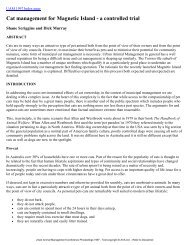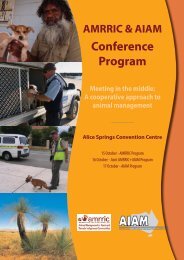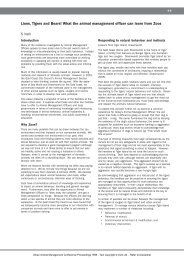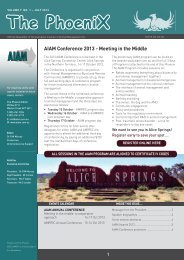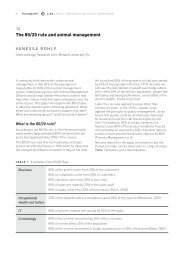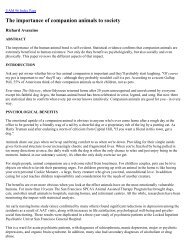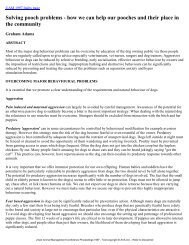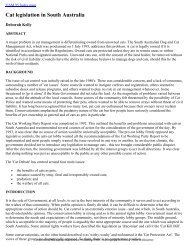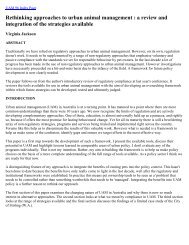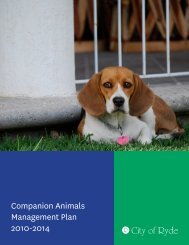Proceedings OF ThE - Australian Institute of Animal Management Inc
Proceedings OF ThE - Australian Institute of Animal Management Inc
Proceedings OF ThE - Australian Institute of Animal Management Inc
Create successful ePaper yourself
Turn your PDF publications into a flip-book with our unique Google optimized e-Paper software.
52 <strong>Proceedings</strong> 2012<br />
AIAM Annual Conference on <strong>Animal</strong> <strong>Management</strong><br />
There must be compromise, trust and respect. Slow<br />
and steady attitudinal change, underpinned by trust,<br />
respect and adequate resources, has been the way<br />
forward in many communities where AMRRIC and the<br />
RSPCA are working.<br />
Consultation, local employment,<br />
knowledge and language<br />
Consulting extensively within the community to<br />
facilitate the development <strong>of</strong> a strategic animal<br />
health and management plan guided by community<br />
needs and circumstances is crucial. Imposing predetermined<br />
programs, developed through non-<br />
Aboriginal eyes can mean little to no sustained<br />
compliance with the approaches undertaken. Without<br />
extensive consultation the vet or provider may arrive<br />
in the community to undertake the pre-decided<br />
program to find that the community, in fear <strong>of</strong> what<br />
is being imposed based on previous history, have<br />
evacuated their dogs to a ‘safer’ place.<br />
Environmental Health Workers (EHWs), and <strong>Animal</strong><br />
<strong>Management</strong> Workers (AMW’s) who work alongside<br />
veterinarians are highly valued and are <strong>of</strong>ten<br />
crucial to a program’s success. Trained AMWs and<br />
EHWs can deliver parasite control programs and<br />
injectable temporary sterilisation <strong>of</strong> animals, assist<br />
vets to understand and navigate local sensitivities,<br />
are educators and surgical assistants and can<br />
provide feedback and data to assist Shires/Councils<br />
with strategic planning. They can undertake the<br />
groundwork to establish a program as they are well<br />
known and trusted by their community, resulting<br />
in a more efficient program. Local issues and<br />
sensitivities that need to be navigated in remote areas<br />
may be ‘ceremony business, dog dreaming or sorry<br />
business’ (Donelan AMRRIC 2006), and the program’s<br />
interaction with politics, social tension and personal<br />
traumas need to be appropriately handled in urban<br />
communities as well.<br />
Local AMW’s can be a wealth <strong>of</strong> knowledge and<br />
provide vital language translation when required.<br />
They ensure that vets and other external staff are<br />
informed <strong>of</strong> cultural differences that they may<br />
otherwise be unaware <strong>of</strong>. “You can go backwards<br />
very quickly in these places if you don’t have the right<br />
help” (Irving cited in Constable and Lucia 2011). The<br />
AMWs are best placed to obtain informed consent<br />
and higher numbers <strong>of</strong> consents that Non Aboriginal<br />
people to treat dogs (81% as against 53%) (Constable<br />
et al 2010).<br />
Conclusion<br />
Progress is being made in many communities<br />
regarding the improvement <strong>of</strong> animal health and<br />
welfare. It is being made through consultation, the<br />
building <strong>of</strong> trustful relationships, engagement, local<br />
employment and education programs. Aboriginal<br />
people in remote communities, on the whole, value<br />
their pets as those non- Aboriginal people on the east<br />
coast do. Over recent years the Federal Government<br />
has come to see the enormous benefits <strong>of</strong> dog health<br />
and welfare programs to improving the overall health<br />
and safety <strong>of</strong> remote communities through the work<br />
and lobbying <strong>of</strong> agencies like AMRRIC and RSPCA.<br />
This is a positive step forward and is allowing some<br />
communities to benefit from veterinary and education<br />
strategies that is making a real difference. Engaged<br />
communities who trust in the slow and steady<br />
respectful approach want to work with us to make<br />
the changes that bring benefits to all.<br />
Sources<br />
<strong>Animal</strong> <strong>Management</strong> in Rural and Remote Indigenous<br />
Communities (AMRRIC), Companion <strong>Animal</strong> Welfare Service<br />
Framework, MacDonnell Shire, 2007.<br />
<strong>Australian</strong> Volunteers International, Building and Maintaining<br />
Relationships in Communities, PP Presentation, Remote<br />
Recruiting Services, 2004.<br />
Boitani L, Francisci F, Ciucci P, and Andreoli G 1995 “Population<br />
biology and ecology <strong>of</strong> feral dogs in central Italy” in Serpell J.A.<br />
(ed) The Domestic Dog: its Evolution, Behaviour, and Interactions with<br />
People Cambridge University Press, Cambridge p 217-244.<br />
Constable S , Brown G, Dixon Rose, Dixon RJ ‘Healing the hand<br />
that feeds you: Exploring solutions for dog and community health and<br />
welfare in <strong>Australian</strong> Indigenous communities’ The International<br />
Conference on Interdisciplinary Social Sciences. 22 to 25 July 2008.<br />
Constable, S and Lucia, S ‘2.89 million will help make <strong>Animal</strong><br />
Health management a reality in the Northern Territory’, The<br />
<strong>Australian</strong> Veterinary Journal, Vol 89, No 6, June 2011.<br />
Constable S., Dixon RM, Dixon RJ, Brown G., 2010 “Walking<br />
Together on Country” AHPA National Conference, Melbourne, May<br />
31st.<br />
Constable, S., Brown, G., Dixon, R.M., and Dixon, R.J. (2011)<br />
The effect <strong>of</strong> veterinary and dog health worker programs<br />
in controlling mange in dogs living in remote Indigenous<br />
communities Unpublished paper.<br />
Corbett L. (2001). The Dingo in Australia and Asia. Marleston, JB<br />
Books.<br />
Donelan T, 2006, ‘To Kill or Control - Humane <strong>Animal</strong><br />
<strong>Management</strong> in a Remote Indigenous <strong>Australian</strong> Community’,<br />
World Small <strong>Animal</strong> Veterinary Association (WSAVA) annual<br />
conference, Mexico City May 2005.<br />
Hardaker J, (2008) Making Sustainable Improvements in <strong>Animal</strong><br />
Welfare ‘A strategic approach to <strong>Animal</strong> Welfare improvement in<br />
remote Indigenous communities’. <strong>Animal</strong> <strong>Management</strong> in Rural and<br />
Remote Indigenous Communities (AMRRIC), <strong>Australian</strong> <strong>Animal</strong><br />
Welfare Strategy Conference Gold Coast.<br />
Holmes, Catherine (2012) Evaluation <strong>of</strong> ‘Caring for Dogs,<br />
Community and Country’ AMRRIC DVD.<br />
Hunt A, <strong>Animal</strong>s and their Importance to Aboriginal Society’, 2006<br />
AMRRIC Dog People Conference <strong>Proceedings</strong>, AMRRIC.<br />
Matter HC and Daniels MJ 2000 “Dog ecology and population<br />
biology” in Macpherson CNL, Meslin FX, and Wandeler AI (eds)<br />
Dogs, Zoonoses and Public Health CABI Publishing Oxford p 17-62.<br />
Phelan S, Conducting Dog Health programs in Remote Indigenous<br />
Communities – A Veterinary Guide, AMRRIC, 2006.<br />
Prendergast M, Dixon R and Lawrie M, 2008, Attitudes <strong>of</strong><br />
Indigenous <strong>Australian</strong>s that may influence uptake <strong>of</strong> desexing<br />
programs: A Case Study. AMRRIC Conference, Darwin, 14th<br />
October 2008.



